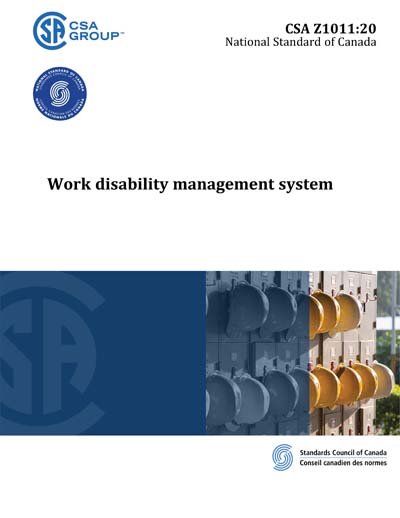Historical
CSA Z1011-2020
Work disability management system
Preface This is the first edition of CSA Z1011, Work disability management system. To facilitate its use and adoption, this Standard is aligned with the Plan-Do-Check-Act (PDCA) continual improvement model found in occupational health and safety management systems (OHSMS) such as CSA Z45001. This Standard is also aligned with the principles and best practices specified in all other publications under CSA Group’s Z1000 suite of standards. It should be noted that, while Federal, Provincial, and Territorial legislation, along with human rights codes and privacy legislation, were considered during the development of this Standard, CSA Z1011 is designed as a management system standard. It is therefore based primarily on best practices for organizations to achieve their goals of optimal workforce engagement, given the health needs of workers as they arise, in order to minimize the possibility or impact of work disability. This Standard has been developed in compliance with Standards Council of Canada requirements for National Standards of Canada. It has been published as a National Standard of Canada by CSA Group. Scope 1.1 General This Standard specifies the requirements for a WDM system that can be used by organizations to systematically manage their WDM activities. This Standard includes a framework for the management of work disability at the organizational level. It is applicable to small, medium, and large organizations in the private, not-for-profit, and public sectors with at least ten workers. 1.2 Structure This Standard provides a framework for organizations to prepare for and respond to work disability via a WDM system approach, which is described as a "WDM system". It includes policies, processes, programs, procedures, and practices related to the following: a) a voluntary framework for WDM at the organizational/system level, including recruitment, hiring, and onboarding of workers with disabilities and the health and well-being needs of workers throughout the employment lifecycle; b) direction on planning, developing, implementing and evaluating the WDM system within the framework (including implementation tips provided in Annex D); and c) requirements for competencies of persons playing key roles in the management of work disability and training appropriate to their level of involvement. 1.3 Application This Standard is intended for use by organizations of all sizes, in all occupational sectors, and across all regions of Canada in the private, public, for profit and not-for-profit sectors. 1.4 Guiding principles The guiding principles that are the foundations for this Standard are a) an evidence-informed, data-driven approach that is strategic in nature to ensure sound policies and processes; b) a focus on inclusion and accessibility to promote engagement and belonging; c) taking a worker-centred, supportive approach that is contextualized and case-by-case; d) promoting accommodation and timely and safe RTW, in case of health-related absences, that consider the essential duties of the worker’s role within the organization; e) joint responsibility of organizational management, the worker/workforce, and worker representatives (where applicable); and f) legal compliance (as applicable in the jurisdiction). 1.5 Terminology In this Standard, "shall" is used to express a requirement, i.e., a provision that the user is obliged to satisfy in order to comply with the Standard; "should" is used to express a recommendation or that which is advised but not required; and "may" is used to express an option or that which is permissible within the limits of the Standard. Notes accompanying clauses do not include requirements or alternative requirements; the purpose of a note accompanying a clause is to separate from the text explanatory or informative material. Notes to tables and figures are considered part of the table or figure and may be written as requirements. Annexes are designated normative (mandatory) or informative (non-mandatory) to define their application.
Content Provider
CSA America, Inc. [csa]






